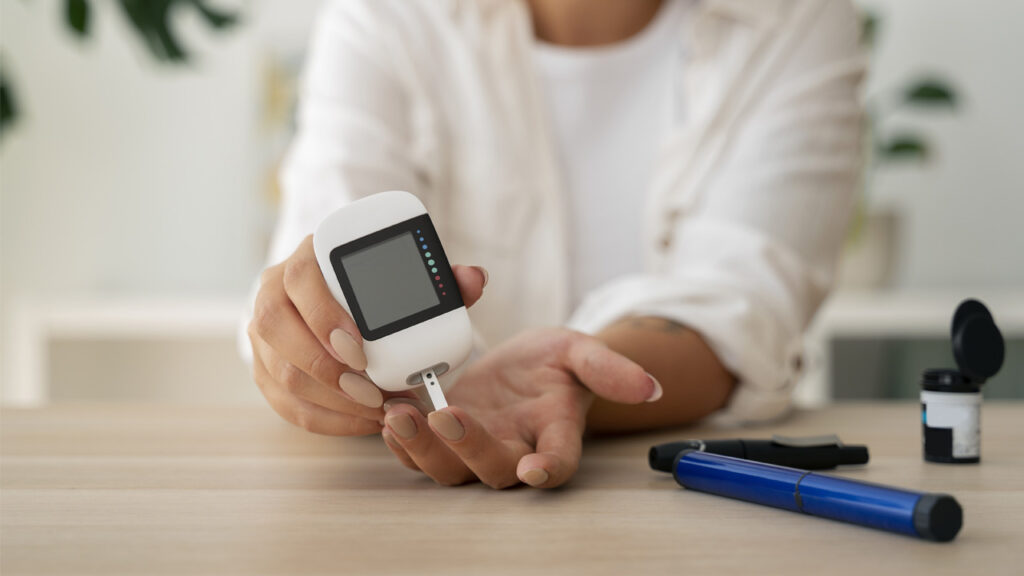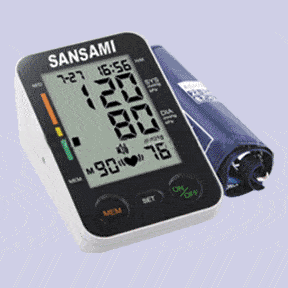Blood Glucose Measuring Meter FIA-Biomed Germany
Blood Glucose Measuring Meter FIA-Biomed Germany FIABiomed Salut Blood Glucose Meter is a measuring device which is able to detect actual blood sugar level and its made by FIABiomed Germany. In our country a lot of brand blood glucose meter are available but FIABiomed Salut is one of the best of them. It has following features which are not able to get other devices in our country. FDA & CE Certified Meter BIRDEM Certified Meter (A Grade) Minimum blood sample required 0.5µL Result within 5 second Big display-easy to read Enzyme Glucose dehydrogense-FAD (this method are able to calculate the sugar level as like as LAB-test) With date and time 999 Test Memory 7, 14, 21 and 28 days before meal and after meal average result calculation. Strip ejection option. Foil and Vial Strips are available. Life time replacement warranty (conditions will apply). Specifications: Measuring Range : 1.1 ~ 33.3 mmol/l Button : S key (Setting) and M key (Memory) Measuring Time : 5 seconds Memory Capacity : 999 Result Setting : before meal, after meal and Control Solution Test setting Average Display : 7, 14, 21, 28 days Before/After meal average. Power Supply : 3 volt Lithium battery (CR 2032) 2 units. Battery Life : Approx. 2000 tests. Automatic -shut off : 3 minutes. Meter Dimension : 90mm (L) x 36mm (w) x 18.5mm (h) Weight : Approx. 70 gram (without battery). Product Enquiry
Keeping Track with Precision: The Essentials of Choosing a Blood Glucose Measuring Meter

Living with diabetes requires constant vigilance and precise management of blood sugar levels. A crucial tool in this endeavor is the blood glucose measuring meter, which provides invaluable data for effective diabetes management. With a plethora of options available in the market, choosing the right meter can be overwhelming. Let’s explore the essentials to consider when selecting a blood glucose measuring meter. Accuracy: The primary purpose of a blood glucose meter is to provide accurate readings. Look for meters that are FDA-approved and have undergone rigorous testing to ensure reliability. Additionally, consider meters with advanced technology, such as glucose oxidase-based sensors, known for their accuracy. Ease of Use: A user-friendly interface and simple operation are essential features, especially for individuals with limited dexterity or vision impairment. Choose a meter with large, easy-to-read display screens, straightforward navigation buttons, and minimal steps for testing. Sample Size: Some meters require smaller blood samples for testing, which can be advantageous for individuals with sensitive skin or those who find it challenging to obtain larger blood samples. Opt for meters that offer alternate site testing options, such as the forearm or palm, for added convenience and comfort. Data Management: Modern blood glucose meters come equipped with features for storing and analyzing data over time. Consider meters that offer memory storage for multiple readings, as well as connectivity options for transferring data to a computer or smartphone app. This enables better tracking of trends and patterns in blood sugar levels, empowering individuals to make informed decisions about their diabetes management. Cost and Insurance Coverage: Blood glucose meters vary in price, ranging from basic models to more advanced devices with additional features. Before making a purchase, consider your budget and whether your insurance plan covers the cost of the meter and testing supplies. Some manufacturers also offer assistance programs or discounts for eligible individuals. Compatibility with Accessories: Check if the meter is compatible with accessories such as lancets, test strips, and control solutions. Ensuring compatibility with readily available supplies can help streamline the testing process and avoid compatibility issues down the line. Customer Support and Training: Look for meters from reputable manufacturers that offer comprehensive customer support and training resources. This includes access to instructional videos, user manuals, and helplines for troubleshooting issues or answering questions about meter operation and maintenance. By considering these essential factors, you can confidently select a blood glucose measuring meter that meets your specific needs and preferences. Remember, regular monitoring of blood sugar levels is vital for effective diabetes management, and choosing the right meter is the first step towards achieving optimal health and well-being.
How Digital Blood Pressure Monitors Are Transforming Health Care

Blood pressure management is a critical component of healthcare, influencing the prevention and treatment of conditions such as hypertension, heart disease, and stroke. Digital blood pressure monitors have become indispensable tools in both clinical settings and home environments. This article explores how these devices are revolutionizing healthcare by improving diagnostic accuracy, enhancing patient engagement, and supporting telemedicine initiatives. রক্তচাপ ব্যবস্থাপনা স্বাস্থ্যসেবার একটি গুরুত্বপূর্ণ উপাদান, যা উচ্চ রক্তচাপ, হৃদরোগ এবং স্ট্রোকের মতো অবস্থার প্রতিরোধ ও চিকিত্সাকে প্রভাবিত করে। ডিজিটাল রক্তচাপ মনিটরগুলি ক্লিনিকাল সেটিংস এবং বাড়ির পরিবেশ উভয় ক্ষেত্রেই অপরিহার্য হাতিয়ার হয়ে উঠেছে। এই নিবন্ধটি অনুসন্ধান করে যে কীভাবে এই ডিভাইসগুলি ডায়াগনস্টিক নির্ভুলতা উন্নত করে, রোগীর ব্যস্ততা বৃদ্ধি করে এবং টেলিমেডিসিন উদ্যোগকে সমর্থন করে স্বাস্থ্যসেবায় বিপ্লব ঘটাচ্ছে। Enhanced Accuracy and Reliability Digital blood pressure monitors have advanced significantly in terms of accuracy and reliability. Equipped with smart technologies, these devices minimize human error and the inconsistencies often associated with manual readings taken by healthcare professionals. Many digital monitors now feature advanced algorithms and sensors that detect blood flow and heart rate more precisely, providing clinicians and patients with data they can trust. ডিজিটাল রক্তচাপ মনিটরগুলি যথার্থতা এবং নির্ভরযোগ্যতার ক্ষেত্রে উল্লেখযোগ্যভাবে অগ্রসর হয়েছে। স্মার্ট প্রযুক্তির সাথে সজ্জিত, এই ডিভাইসগুলি মানুষের ত্রুটি এবং স্বাস্থ্যসেবা পেশাদারদের দ্বারা নেওয়া ম্যানুয়াল রিডিংয়ের সাথে সম্পর্কিত অসঙ্গতিগুলিকে কমিয়ে দেয়। অনেক ডিজিটাল মনিটরে এখন উন্নত অ্যালগরিদম এবং সেন্সর রয়েছে যা রক্তের প্রবাহ এবং হৃদস্পন্দনকে আরও সুনির্দিষ্টভাবে সনাক্ত করে, চিকিত্সক এবং রোগীদের তারা বিশ্বাস করতে পারে এমন ডেটা সরবরাহ করে। Increased Accessibility and Patient Empowerment The accessibility of digital blood pressure monitors allows patients to take control of their health outside the clinical environment. Easy-to-use interfaces and portable designs enable individuals to monitor their blood pressure at home regularly, fostering greater self-management of hypertension. This accessibility not only empowers patients but also helps in early detection of potential health issues, allowing for timely medical intervention. ডিজিটাল রক্তচাপ মনিটরের অ্যাক্সেসিবিলিটি রোগীদের ক্লিনিকাল পরিবেশের বাইরে তাদের স্বাস্থ্যের নিয়ন্ত্রণ নিতে দেয়। সহজে ব্যবহারযোগ্য ইন্টারফেস এবং পোর্টেবল ডিজাইন ব্যক্তিদের বাড়িতে নিয়মিত তাদের রক্তচাপ নিরীক্ষণ করতে সক্ষম করে, উচ্চ রক্তচাপের বৃহত্তর স্ব-ব্যবস্থাপনাকে উৎসাহিত করে। এই অ্যাক্সেসিবিলিটি শুধুমাত্র রোগীদের ক্ষমতায়নই করে না বরং সম্ভাব্য স্বাস্থ্য সমস্যাগুলির প্রাথমিক সনাক্তকরণেও সাহায্য করে, যা সময়মত চিকিৎসা হস্তক্ষেপের অনুমতি দেয়। Support for Telemedicine and Remote Monitoring As telemedicine continues to grow, digital blood pressure monitors play a crucial role in facilitating remote healthcare services. These devices can transmit measurements directly to healthcare providers in real-time, enabling ongoing monitoring of patients’ conditions without the need for physical office visits. This capability is particularly beneficial for rural or underserved populations, as well as for patients with mobility limitations. টেলিমেডিসিন ক্রমাগত বৃদ্ধির সাথে সাথে, ডিজিটাল রক্তচাপ মনিটরগুলি দূরবর্তী স্বাস্থ্যসেবা পরিষেবাগুলিকে সহজতর করার জন্য একটি গুরুত্বপূর্ণ ভূমিকা পালন করে৷ এই ডিভাইসগুলি বাস্তব সময়ে স্বাস্থ্যসেবা প্রদানকারীদের কাছে সরাসরি পরিমাপ প্রেরণ করতে পারে, শারীরিক অফিস পরিদর্শনের প্রয়োজন ছাড়াই রোগীদের অবস্থার চলমান পর্যবেক্ষণ সক্ষম করে। এই ক্ষমতা বিশেষ করে গ্রামীণ বা অপ্রতুল জনসংখ্যার জন্য উপকারী, সেইসাথে গতিশীলতা সীমাবদ্ধ রোগীদের জন্য। Cost-Effectiveness and Efficiency Digital blood pressure monitors contribute to cost savings in healthcare by reducing the need for frequent doctor visits and hospitalizations due to better managed and controlled blood pressure levels. They also save time for healthcare providers by offering quick and easy assessments of patient blood pressure, allowing for more efficient patient management. ডিজিটাল রক্তচাপ মনিটরগুলি ভালভাবে পরিচালিত এবং নিয়ন্ত্রিত রক্তচাপের মাত্রার কারণে ঘন ঘন ডাক্তারের পরিদর্শন এবং হাসপাতালে ভর্তির প্রয়োজনীয়তা হ্রাস করে স্বাস্থ্যসেবায় খরচ সাশ্রয়ে অবদান রাখে। তারা রোগীর রক্তচাপের দ্রুত এবং সহজ মূল্যায়নের প্রস্তাব দিয়ে স্বাস্থ্যসেবা প্রদানকারীদের জন্য সময় বাঁচায়, আরও দক্ষ রোগী পরিচালনার অনুমতি দেয়। Integration with Health Management Systems Many digital blood pressure monitors can integrate seamlessly with electronic health records (EHRs) and other health management systems. This integration facilitates the comprehensive tracking of a patient’s health data, enabling healthcare providers to make more informed decisions based on long-term trends and data analytics. It also supports holistic management of a patient’s condition, considering blood pressure readings in conjunction with other vital signs. অনেক ডিজিটাল রক্তচাপ মনিটর ইলেকট্রনিক হেলথ রেকর্ডস (EHRs) এবং অন্যান্য স্বাস্থ্য ব্যবস্থাপনা সিস্টেমের সাথে নির্বিঘ্নে একত্রিত করতে পারে। এই ইন্টিগ্রেশন রোগীর স্বাস্থ্য ডেটার ব্যাপক ট্র্যাকিংয়ের সুবিধা দেয়, স্বাস্থ্যসেবা প্রদানকারীদের দীর্ঘমেয়াদী প্রবণতা এবং ডেটা বিশ্লেষণের উপর ভিত্তি করে আরও সচেতন সিদ্ধান্ত নিতে সক্ষম করে। এটি অন্যান্য অত্যাবশ্যক লক্ষণগুলির সাথে একত্রে রক্তচাপের রিডিং বিবেচনা করে রোগীর অবস্থার সামগ্রিক ব্যবস্থাপনাকেও সমর্থন করে। Conclusion Digital blood pressure monitors are more than just gadgets; they are integral tools that are reshaping healthcare practices around the globe. By improving accuracy, empowering patients, supporting remote healthcare, and integrating with broader health management systems, these monitors are helping to build a more efficient, accessible, and proactive healthcare landscape. As technology advances, the potential for these devices to further enhance health care delivery and patient outcomes continues to expand, marking a promising future for digital health technology. ডিজিটাল ব্লাড প্রেসার মনিটর শুধু গ্যাজেটের চেয়ে বেশি; এগুলি অবিচ্ছেদ্য সরঞ্জাম যা বিশ্বজুড়ে স্বাস্থ্যসেবা অনুশীলনকে পুনর্নির্মাণ করছে। নির্ভুলতা উন্নত করে, রোগীদের ক্ষমতায়ন করে, দূরবর্তী স্বাস্থ্যসেবা সমর্থন করে এবং বৃহত্তর স্বাস্থ্য ব্যবস্থাপনা সিস্টেমের সাথে একীভূত করে, এই মনিটরগুলি আরও দক্ষ, অ্যাক্সেসযোগ্য এবং সক্রিয় স্বাস্থ্যসেবা ল্যান্ডস্কেপ তৈরি করতে সহায়তা করছে। প্রযুক্তির অগ্রগতির সাথে সাথে, এই ডিভাইসগুলির স্বাস্থ্যসেবা সরবরাহ এবং রোগীর ফলাফলকে আরও উন্নত করার সম্ভাবনা প্রসারিত হতে থাকে, ডিজিটাল স্বাস্থ্য প্রযুক্তির জন্য একটি প্রতিশ্রুতিশীল ভবিষ্যত চিহ্নিত করে।
The Vital Role of Blood Collection Tubes in Modern Diagnostics

Blood collection tubes, though small, play an enormous role in modern diagnostics, serving as the foundational elements for accurate and efficient laboratory testing. These simple devices are critical for obtaining and preserving blood specimens, which are analyzed to diagnose a myriad of health conditions, from routine lipid panels to complex genetic markers. This article explores the essential function and impact of blood collection tubes in contemporary healthcare. Standardization and Precision Blood collection tubes are designed to provide a standard, controlled environment for blood samples. They come in various types, each tailored for specific kinds of tests and treatments, with different additives that preserve the blood in distinct ways depending on the diagnostic requirements. For example, tubes containing anticoagulants such as EDTA are used for complete blood counts, while those with a gel separator are favored for serum-based tests. This specialization ensures that the integrity of the blood sample is maintained, leading to more precise diagnostic outcomes. Enhancing Diagnostic Accuracy The use of standardized blood collection tubes directly impacts the accuracy of diagnostic tests. The additives in these tubes can prevent blood clotting, preserve glucose levels, stabilize cellular components, or inhibit microbial growth, depending on the diagnostic needs. This preservation is vital for ensuring that the blood sample remains as close to its original state as possible, thus providing clinicians with reliable data for making accurate medical diagnoses. Safety and Hygiene Modern blood collection tubes are designed with safety and hygiene in mind, both for the patient and the healthcare professional. Most tubes now feature safety caps that prevent spillage and minimize the risk of exposure to bloodborne pathogens. Additionally, the color-coded caps on the tubes help prevent errors in sample handling by clearly delineating different types of tests, thereby enhancing the overall safety and efficiency of the blood collection process. Streamlining Laboratory Operations Blood collection tubes facilitate a streamlined workflow in laboratory settings. Their uniform size and design allow for easy integration with automated testing equipment, reducing manual handling and the associated risks of errors. Moreover, the barcode labels on these tubes can be scanned to track the sample through each stage of testing, ensuring that results are accurately recorded and attributed to the correct patient. Supporting Advances in Medical Research Beyond routine diagnostics, blood collection tubes are instrumental in medical research, enabling the study of biomarkers, genetic research, and the development of new medical treatments. Researchers rely on the high-quality, well-preserved blood samples these tubes provide to conduct accurate and reproducible experiments, pushing the boundaries of medical science and improving future healthcare. Conclusion Blood collection tubes are unsung heroes in the domain of medical diagnostics. By enabling precise sample collection and preservation, they play a crucial role in ensuring diagnostic accuracy, enhancing patient safety, and supporting medical research. As technology advances, the development of even more specialized blood collection tubes will likely emerge, further refining diagnostic capabilities and contributing to the evolution of global healthcare standards.
Illuminating Diagnostics: The Benefits of Using an LED X-Ray Film Viewer in Medical Imaging

In the realm of medical imaging, the quality of every diagnostic tool and device plays a critical role in ensuring accurate patient diagnoses. LED X-ray film viewers represent a significant advancement over traditional film viewing methods, bringing numerous benefits to both healthcare providers and patients. This article explores the advantages of using LED technology in X-ray film viewers and its impact on medical imaging. Enhanced Image Quality One of the primary benefits of LED X-ray film viewers is the superior image quality they offer. LED lighting provides a brighter, more consistent light source, which is crucial for accurately interpreting X-ray films. Unlike traditional fluorescent bulbs, LEDs do not produce hotspots or uneven lighting, ensuring that the entire X-ray film is illuminated uniformly. This uniformity allows radiologists and medical professionals to detect minute details and subtle differences in the images, which are essential for accurate diagnoses. Energy Efficiency and Longevity LEDs are well-known for their energy efficiency, consuming significantly less power than traditional lighting solutions. This not only helps healthcare facilities reduce their energy costs but also contributes to environmental sustainability. Additionally, LED lights have a much longer lifespan, reducing the need for frequent replacements. This longevity ensures that the X-ray film viewers are available whenever needed, with minimal downtime for maintenance. Reduced Heat Emission Traditional X-ray film viewers often use fluorescent or incandescent bulbs, which can emit a considerable amount of heat. This can lead to discomfort for the user, especially during prolonged use, and can even affect the integrity of the X-ray films over time. LED lights emit very little heat, making them safer and more comfortable to use. This feature also helps preserve the quality of the X-ray films by reducing the risk of heat damage. Improved Diagnostic Accuracy The clarity and uniform lighting provided by LED X-ray film viewers enhance the diagnostic accuracy. Clear visibility of all areas of an X-ray film is crucial for spotting fractures, tumors, and other abnormalities. LEDs enhance the contrast and sharpness of the images, allowing for better differentiation between various tissues and structures. This level of detail is vital for making informed medical decisions and planning appropriate treatments. Ergonomic Design and User Comfort Modern LED X-ray film viewers often feature ergonomic designs that enhance user comfort and efficiency. These viewers can come with adjustable brightness settings, allowing medical staff to customize the lighting according to their specific needs and preferences. Such features reduce eye strain and fatigue, particularly important in settings where professionals need to examine multiple films back-to-back. Conclusion The integration of LED technology into X-ray film viewers has transformed the landscape of medical imaging. By providing enhanced image quality, energy efficiency, reduced heat emission, and improved diagnostic accuracy, LED X-ray film viewers have become invaluable tools in modern healthcare facilities. Their use not only supports the precise and effective diagnosis of patient conditions but also contributes to a more sustainable, cost-effective, and ergonomically friendly work environment. As medical technology continues to evolve, the role of LED in diagnostic imaging will likely expand, further enhancing the capabilities of healthcare professionals in providing top-tier medical care.
The Future of Patient Care: Innovations in Digital Patient Monitoring Systems

In an era where technology is increasingly intertwined with every aspect of healthcare, digital patient monitoring systems stand out as pivotal innovations. These systems, which collect and analyze patient data continuously, are transforming the landscape of patient care, improving outcomes, and optimizing healthcare delivery. This article explores the advancements and the promising future of digital patient monitoring in enhancing patient care. Continuous Health Monitoring One of the core features of digital patient monitoring systems is their ability to monitor patients continuously. Unlike traditional methods that rely on periodic health checks, these digital systems track vital signs such as heart rate, blood pressure, oxygen saturation, and other parameters in real time. This continuous monitoring allows for immediate detection of anomalies or deterioration in a patient’s condition, enabling prompt intervention which can be critical in preventing complications and improving patient outcomes. Enhanced Data Accuracy and Accessibility Digital patient monitoring systems leverage advanced sensors and algorithms to ensure data accuracy and reliability. This technology minimizes human error and provides a more comprehensive view of a patient’s health status over time. Additionally, this data is often cloud-based, making it accessible to healthcare providers regardless of their location. Such accessibility is crucial for timely decision-making, especially in critical care scenarios or in managing chronic conditions. Predictive Analytics and Personalized Care The integration of artificial intelligence (AI) and machine learning (ML) with digital patient monitoring systems is paving the way for predictive healthcare analytics. By analyzing vast amounts of historical and real-time data, these systems can identify patterns that predict potential health issues before they become severe. This capability enables healthcare providers to offer personalized care plans based on individual risk factors and anticipated needs, thus enhancing patient care through preemptive medical intervention. Telemedicine and Remote Patient Monitoring Digital patient monitoring systems are integral to the growth of telemedicine and remote patient care. For patients in remote areas or those with mobility challenges, these systems provide a link to necessary healthcare services without the need for physical travel. Remote monitoring not only makes healthcare more accessible but also reduces the burden on healthcare facilities, frees up resources, and decreases the risk of transmitting infectious diseases. Improving Patient Engagement and Compliance These systems often come with patient-facing interfaces, such as apps or web portals, that engage patients in their own care by providing them with easy access to their health data. This transparency helps increase patient awareness and involvement in their treatment plans, leading to better adherence to prescribed therapies and lifestyle changes. Moreover, patients can receive customized alerts and health tips, further encouraging proactive health management. Conclusion Digital patient monitoring systems are redefining the paradigms of patient care through their revolutionary capabilities in continuous monitoring, data management, predictive analytics, and patient engagement. As these systems evolve, they will continue to enhance the efficiency of healthcare providers, improve patient outcomes, and drive the global healthcare industry towards a more connected, predictive, and personalized future. The ongoing advancements in this technology signal a promising horizon for patient care, where health interventions are not only reactive but also increasingly preventive and precise.
Seeing Beyond the Surface: Advances in 3D/4D Color Doppler Ultrasound Technology

Ultrasound technology has long been a cornerstone in medical diagnostics, offering non-invasive insights into the human body. Recent advancements in 3D/4D Color Doppler ultrasound technology have pushed the boundaries even further, providing unprecedented detail and dynamic insights into bodily structures and blood flow. This article delves into the latest developments in 3D/4D Doppler technology and their transformative impact on medical diagnostics. Enhanced Image Quality and Detail Traditional 2D ultrasound provides flat, grayscale images that can be limited in detail. In contrast, 3D ultrasound creates three-dimensional images, offering a much clearer view of anatomical structures. Adding a fourth dimension—time—4D ultrasound delivers these three-dimensional images in motion. This real-time visualization allows for a more comprehensive analysis of anatomical structures as they function, providing crucial insights into physiological processes. The integration of Color Doppler with these technologies adds another layer of utility, allowing clinicians to visualize blood flow within the vessels. The color imaging distinguishes the direction and speed of blood flow, differentiating it from surrounding tissues. This capability is critical in assessing vascular health, diagnosing blockages, and evaluating blood flow to organs and tumors. Advances in Obstetrics and Gynecology One of the most impactful applications of 3D/4D Color Doppler ultrasound is in the field of obstetrics and gynecology. These advanced ultrasounds enable doctors to examine the fetal heart more precisely, assess anomalies, monitor the health of the placenta, and observe fetal movements in real-time. Such detailed imaging improves prenatal diagnostics and enhances the bonding experience between parents and their unborn child by providing clearer images of the fetus. Cardiology and Vascular Health In cardiology, 3D/4D Color Doppler technology revolutionizes the way heart conditions are diagnosed and monitored. Clinicians can now view the heart from any angle, assess heart valve function, and observe blood flow through various chambers and vessels in real-time. This technology is particularly valuable for diagnosing congenital heart diseases, valve malfunctions, and other cardiovascular conditions. Improved Surgical Planning and Guidance The detailed imaging provided by 3D/4D Color Doppler ultrasound is also invaluable in surgical planning. Surgeons can use these detailed images to plan complex procedures, such as transplant surgeries or tumor resections, with greater precision. Additionally, real-time 4D imaging can be used intraoperatively to guide surgical interventions, ensuring that surgeons can navigate complicated procedures with more accuracy. Streamlining Diagnostic Processes The advancements in 3D/4D Color Doppler ultrasound technology not only improve diagnostic accuracy but also streamline the diagnostic process. Faster scanning times combined with higher quality images reduce the need for multiple tests and follow-up appointments, allowing for quicker diagnosis and treatment planning. This efficiency not only improves patient care but also enhances the overall throughput in medical facilities. Conclusion The advancements in 3D/4D Color Doppler ultrasound technology represent a significant leap forward in diagnostic imaging. By providing detailed images and real-time, dynamic observation of the body’s internal workings, these tools offer a deeper understanding of a wide range of medical conditions, from prenatal development to cardiovascular diseases. As this technology continues to evolve, its integration into clinical practice promises to further enhance the accuracy of diagnostics and the effectiveness of treatments, ultimately improving patient outcomes across various fields of medicine.
Shining a Light on Surgical Precision: The Critical Role of OT Lights in Modern Surgery

Operating theater (OT) lights are indispensable tools in the realm of surgical healthcare, providing the necessary illumination that enables surgeons to perform intricate procedures with the highest level of precision and safety. This article explores the evolution, technology, and crucial role of OT lights in modern surgical settings, emphasizing their impact on the success of operations and patient outcomes. The Evolution of OT Lights: The development of OT lights has mirrored advances in surgical techniques and technologies. From the early days of simple overhead lights to today’s sophisticated, adjustable fixtures, OT lights have undergone significant transformations. Modern OT lights utilize LED technology, which offers numerous benefits over traditional halogen bulbs, including greater energy efficiency, lower heat production, and a longer lifespan. Importance of Proper Illumination in Surgery: In surgery, visibility is paramount. The surgical field must be adequately illuminated to ensure that surgeons can see with absolute clarity. This is vital for identifying minute anatomical details and avoiding surgical errors. OT lights are designed to provide a high-intensity, focused light that minimizes shadows and enhances the contrast of tissues. This level of illumination is crucial not only for the precision of cutting and suturing but also for spotting delicate nerves, blood vessels, and tissues that must be treated with care. Technological Advancements in OT Lighting: The latest models of OT lights come equipped with features that significantly enhance their functionality and effectiveness: LED Technology: Modern OT lights often use LEDs, which provide bright, white light that closely mimics natural daylight. This quality of light helps in accurately representing the true colors of organs and tissues, which is crucial for surgical accuracy. Adjustability and Control: Advanced OT lights offer unparalleled control over both the intensity and the focus of the light beam. Surgeons can adjust the size and pattern of the light to suit specific procedural needs, minimizing glare and optimizing visibility. Shadow Reduction: Cutting-edge designs incorporate multiple light sources that are positioned in such a way as to minimize shadows cast by surgeons’ hands or instruments. This feature is crucial for maintaining an unobstructed view of the surgical site. Heat Management: Modern OT lights produce less heat, reducing the risk of drying out exposed tissues during long surgeries and providing a more comfortable environment for both the medical team and the patient. Ergonomics and Design: The design of OT lights has also evolved to include better ergonomics, ensuring that they can be easily and swiftly maneuvered into the optimal position without disrupting the sterile environment. The lights are often mounted on adjustable arms that are easy to move, yet stable enough to remain in the desired position without drifting. Impact on Surgical Outcomes: The quality of OT lights can directly influence surgical outcomes. Superior illumination reduces the risk of errors, decreases surgery times, and contributes to overall safer surgical practices. Moreover, the right lighting supports the surgical team’s endurance and focus over long periods, reducing eye strain and fatigue. Conclusion: OT lights are more than just fixtures; they are critical components of the surgical environment that contribute significantly to the success of every procedure. As surgical techniques continue to advance, the demand for innovative lighting solutions that provide optimal visibility and flexibility will continue to grow. The ongoing developments in OT light technology not only reflect the sophistication of modern medicine but also underscore a commitment to achieving the best possible patient outcomes in surgical care.
S S International is a specialized supplier of medical, electrical and electronics products.

About S S International S S International is a specialized supplier of medical, electrical and electronics products. Our number one priority is customer satisfaction and we achieve this through professional customer support and quality products. Quality is the most important requirement for medical, electrical and electronics products, we work with most qualified factories, most of the products have CE, FDA and BIRDEM certification, but we guarantee your satisfaction on our entire product line. Our knowledge and experience in the markets ensure that we provide our customers with exceptional service. We offer complete support from the beginning. We offer a wide variety of products from different demands, but our knowledge team can assist in personalized solutions, our bottom line is to provide customer satisfaction. Our goal is to achieve long-term co-operation. This is accomplished not only through quality products, but also striving to provide the best pricing to our customers. We are eager to help you with whatever. You may be looking for one. Our response time is quick, so feel free to contact us today with any questions. We look forward to serving you.
Message from the CEO | S S International

Dear Valued Customers and Partners, I am Engr. Mohammad Abdur Rahman, CEO of S S International, and I extend a warm welcome to you all. At S S International, we are driven by a singular mission: to ensure the utmost satisfaction of our clients through the provision of high-quality medical, electrical, and electronics products. Our commitment to excellence is at the core of our business, and is evident in every product we offer and every interaction we have. Our journey began with a clear vision—to excel in the highly specialized and demanding sectors of medical, electrical, and electronics supplies. We recognize that the stakes are high in these industries, and that our products are critical for the wellbeing and success of our customers. This understanding is woven into the fabric of our operations, guiding our choices and initiatives. Quality is the cornerstone of our business. We collaborate exclusively with factories that meet the highest standards of production, as evidenced by their CE, FDA, and BIRDEM certifications. But we go beyond these certifications; we guarantee satisfaction with every item in our product line. We believe that true quality transcends basic requirements—it must be felt and appreciated by the end user, and this belief fuels our commitment to excellence. Our dedicated team is key to our success. With deep expertise and an unyielding passion for service, we provide personalized solutions that meet diverse client needs. We support you from the first point of contact, ensuring that every experience with us is smooth, informative, and beneficial. As we look to the future, our focus remains on building long-term cooperation with you. We strive not only to offer quality products but also to provide the most competitive pricing. Our aim is clear—to be your preferred partner, assisting you in achieving your objectives by offering products and services that exceed expectations. We are always here to support you. Whether you have a question about a product or need guidance on choosing the right solution, our team is ready to provide prompt and professional assistance. Thank you for choosing S S International. We value your trust and are excited to continue serving you with integrity and excellence. Warm regards, Engr. Mohammad Abdur Rahman CEO, S S International
